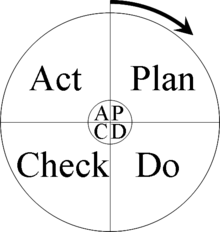| Revision as of 17:06, 30 January 2008 editDanielPenfield (talk | contribs)Extended confirmed users38,642 edits rvv← Previous edit | Revision as of 16:18, 31 January 2008 edit undoHanvanloon (talk | contribs)175 edits Undid revision 187948561 by DanielPenfield (talk)Next edit → | ||
| Line 66: | Line 66: | ||
| :''Note: Before adding your company's link, please read ] and ].'' | :''Note: Before adding your company's link, please read ] and ].'' | ||
| * | |||
| * | * | ||
Revision as of 16:18, 31 January 2008
PDCA ("Plan-Do-Check-Act") is an iterative four-step problem-solving process typically used in quality control. It is also known as the Deming Cycle, Shewhart cycle, Deming Wheel, or Plan-Do-Study-Act.
Meaning

- PLAN
- Establish the objectives and processes necessary to deliver results in accordance with the specifications.
- DO
- Implement the processes.
- CHECK
- Monitor and evaluate the processes and results against objectives and Specifications and report the outcome.
- ACT
- Apply actions to the outcome for necessary improvement. This means reviewing all steps (Plan, Do, Check, Act) and modifying the process to improve it before its next implementation.
About
PDCA was made popular by Dr. W. Edwards Deming, who is considered by many to be the father of modern quality control; however it was always referred to by him as the "Shewhart cycle." Later in Deming's career, he modified PDCA to "Plan, Do, Study, Act" (PDSA) so as to better describe his recommendations.
The concept of PDCA comes out of the Scientific Method, as developed from the work of Francis Bacon (Novum Organum, 1620). The scientific method can be written as "hypothesis" - "experiment" - "evaluation" or Plan, Do, and Check. Shewhart described manufacture under "control" - under statistical control - as a three step process of specification, production, and inspection. Shewhart, 1980, pg. 45. he also specifically related this to the Scientific Method of hypothesis, experiment and evaluation. Shewhart, pg. 48 says that the statistician "must help to change the demand by showing...how to close up the tolerance range and to improve the quality of goods." Clearly, Shewhart intended the analyst to take action based on the conclusions of the evaluation. According to Deming Deming, 1986, pg. 88 during his lectures in Japan in the early 1950's the Japanese participants shortened the steps to the now traditional Plan, Do, Check, Act. Deming preferred Plan, Do, Study, Act because 'Study' has connotations in English closer to Shewhart's intent than "Check." In recognition of this perhaps we should make all references to PDSA, not PDCA.
A fundamental principle of the scientific method and PDSA, is iteration - once an hypothesis is confirmed (or negated), executing the cycle again will extend the knowledge further. Repeating the PDSA cycle can bring us closer to the goal, usually a perfect operation and output.
In Six Sigma programs, the PDSA cycle is called "Define, Measure, Analyze, Improve, Control" (DMAIC). The iterative nature of the cycle must be explicitly added to the DMAIC procedure.
PDSA should be repeatedly implemented in spirals of increasing knowledge of the system that converge on the ultimate goal, each cycle closer than the previous. One can envision an open coil spring, with each loop being one cycle of the Scientific Method - PDSA, and each complete cycle indicating an increase in our knowledge of the system under study. This approach is based on the belief that our knowledge and skills are limited, but improving. Especially at the start of a project, key information may not be known; the PDSA - scientific method - provides feedback to justify our guesses (hypotheses) and increase our knowledge. Rather than enter "analysis paralysis" to get it perfect the first time, it is better to be approximately right than exactly wrong. With the improved knowledge, we may choose to refine or alter the goal (ideal state). Certainly, the PDSA approach can bring us closer to whatever goal we choose.
Rate of change -- rate of improvement— is a key competitive factor in today's world. PDSA allows for major 'jumps' in performance ('breakthroughs' often desired in a Western approach), as well as Kaizen (frequent small improvements associated with an Eastern approach). In the United States a PDSA approach is usually associated with a sizable project involving numerous people's time, and thus managers want to see large 'breakthrough' improvements to justify the effort expended. However, the Scientific Method and PDSA apply to all sorts of projects and improvement activities.
The power of Deming's concept is in its apparent simplicity. The concept of feedback in the Scientific Method (aka inductive logic), in the abstract sense, is today firmly rooted in education. While apparently easy to understand, it is often difficult to accomplish on a on-going basis due to the intellectual difficulty of judging one's proposals (hypotheses) on the basis of measured results. Many people have an emotional fear of being shown "wrong," even by objective measurements. To avoid such comparisons, we may instead cite complacency, distractions, loss of focus, lack of commitment, re-assigned priorities, lack of resources, etc.
References
- Shewhart, Walter Andrew (1939). Statistical Method from the Viewpoint of Quality Control. New York: Dover. ISBN 0-486-65232-7.
- Shewhart, Walter Andrew (1980). Economic Control of Quality of Manufactured Product/50th Anniversary Commemorative Issue. American Society for Quality. ISBN 0-87389-076-0.
- Deming, W. Edwards (1986). Out of the Crisis. MIT Center for Advanced Engineering Study. ISBN 0-911379-01-0.
See also
External links
- Note: Before adding your company's link, please read WP:Spam#External_link_spamming and WP:External_links#Links_normally_to_be_avoided.